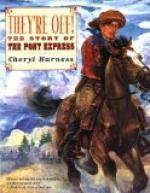That only one rider was ever taken by the savages was due to the fact that the pony men rode magnificent horses which invariably outclassed the Indian ponies in speed and endurance. The lone man captured while on duty was completely surrounded by a large number of savages on the Platte River in Nebraska. He was shot dead and though his body was not found for several days, his pony, bridled and saddled, escaped safely with the mail which was duly forwarded to its destination. That far more riders were killed or injured while off duty than when in the saddle was due solely to the wise precaution of the Company in selecting such high-grade riding stock. And it took the best of horseflesh to make the schedule.
The riders dressed as they saw fit. The average costume consisted of a buckskin shirt, ordinary trousers tucked into high leather boots, and a slouch hat or cap. They always went armed. At first a Spencer carbine was carried strapped to the rider’s back, besides a sheath knife at his side. In the saddle holsters he carried a pair of Colt’s revolvers. After a time the carbines were left off and only side arms taken along. The carrying of larger guns meant extra weight, and it was made a rule of the Company that a rider should never fight unless compelled to do so. He was to depend wholly upon speed for safety. The record of the service fully justified this policy.
While the horses were of the highest grade, they were of mixed breed and were purchased over a wide range of territory. Good results were obtained from blooded animals from the Missouri Valley, but considerable preference was shown for the western-bred mustangs. These animals were about fourteen hands high and averaged less than nine hundred pounds in weight. A former blacksmith for the Company who was at one time located at Seneca, Kansas, recalls that one of these native ponies often had to be thrown and staked down with a rope tied to each foot before it could be shod. Then, before the smith could pare the hoofs and nail on the shoes, it was necessary for one man to sit astride the animal’s head, and another on its body, while the beast continued to struggle and squeal. To shoe one of these animals often required a half day of strenuous work.
As might be expected, the horse as well as rider traveled very light. The combined weight of the saddle, bridle and saddle bags did not exceed thirteen pounds. The saddle-bag used by the pony rider for carrying mail was called a mochila; it had openings in the center so it would fit snugly over the horn and tree of the saddle and yet be removable without delay. The mochila had four pockets called cantinas in each of its corners one in front and one behind each of the rider’s legs. These cantinas held the mail. All were kept carefully locked and three were opened en route only at military posts — Forts Kearney, Laramie, Bridger, Churchill and at Salt Lake City. The fourth pocket was for the local or way mail-stations. Each local station-keeper had a key and could open it when necessary. It held a time-card on which a record of the arrival and departure at the various stations where it was opened, was kept. Only one mochila was used on a trip; it was transferred by the rider from one horse to another until the destination was reached.




